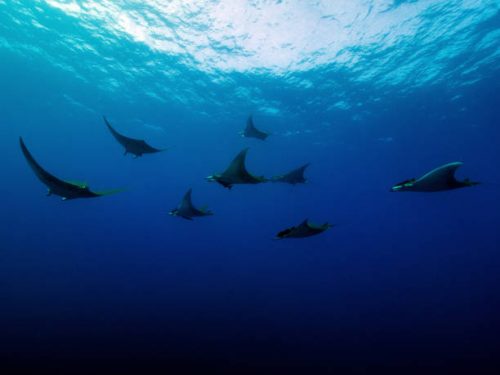The feared Komodo Dragons live on Komodo Island, which is well-known. These massive lizards are the world’s largest and were known to live on the island long before humans arrived. It’s also worth noting that the Komodo Dragon is named after the island of Komodo, rather than vice versa. The island is well-known for its diving spots, in addition to being the home of the Komodo Dragons. All year, the waters are known for their excellent diving conditions. The Komodo diving season is an excellent time to see Manta Rays and Sunfish, which like to swim in the crystal clear waters.

Komodo diving season – Manta Ray season
Manta Rays can be seen in Komodo during the Manta Season, which runs from December to February. The water temperature in the South is lower than in the North at this time of year. The plankton bloom is also in full swing, attracting the majestic Manta Rays to feed on them.
Divers can observe the Mantas feeding on the tiny planktons and even swim alongside them to appreciate how beautiful and gentle they are. Divers should exercise caution because the water will have strong currents that are better suited to experienced divers.
Komodo diving has two distinct dive areas: North Komodo and South Komodo. Even though they are geographically close, these areas are frequently worlds apart in terms of conditions.
Scuba diving Komodo – Mola mola season
One of the world’s most recognizable pelagics is the Ocean Sunfish. Divers enjoy seeing it because of its broad shape and docile nature. Their name is derived from their peculiar behavior, as they like to float near the surface during the cold season to bask in the sun’s rays. Divers can see the Mola – Mola Sunfish during August, when they can be seen resurfacing from deeper waters.
Komodo Island is truly endowed with some of Indonesia’s most exotic animal species. Its waters also provide excellent diving conditions for divers to see Manta Rays and Mola – Mola Sunfish.
Komodo island scuba diving condition
Every dive site has very strong currents, so diving in Komodo is mostly reserved for experienced divers who are comfortable with drift diving!
There are some calmer dive sites for beginners, but you may miss out on the incredible action of big fish swimming into the current.
In some places, the current can reach 8 knots. It is influenced by tides, so choose your dive site carefully and plan ahead of time. The Komodo and Rinca islands act as a bottleneck between the Indian and Pacific oceans, causing this current. This current is responsible for the clarity and abundance of fish in Komodo waters.
Dive Safety
If you are planning a dive trip or traveling to Komodo Island, it is a good idea to invest in scuba diving travel insurance because you never know what could happen or when you might need it (accidents do happen!). I recommend this diving insurance because it provides worldwide coverage and focuses on providing quality insurance and medical assistance to scuba divers.